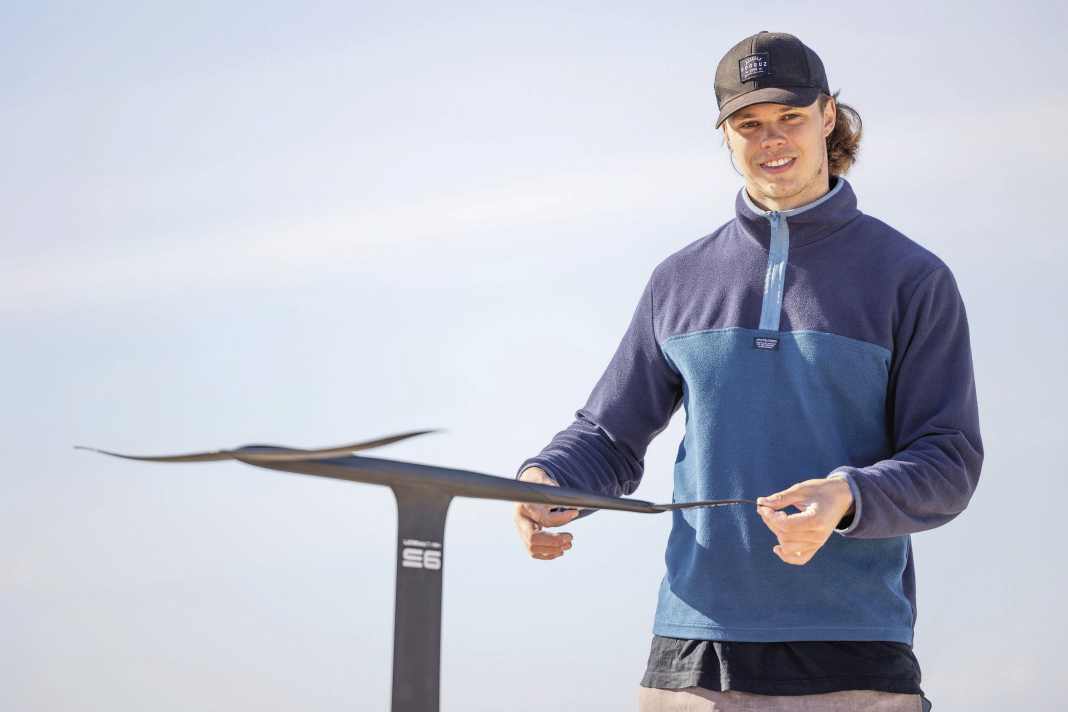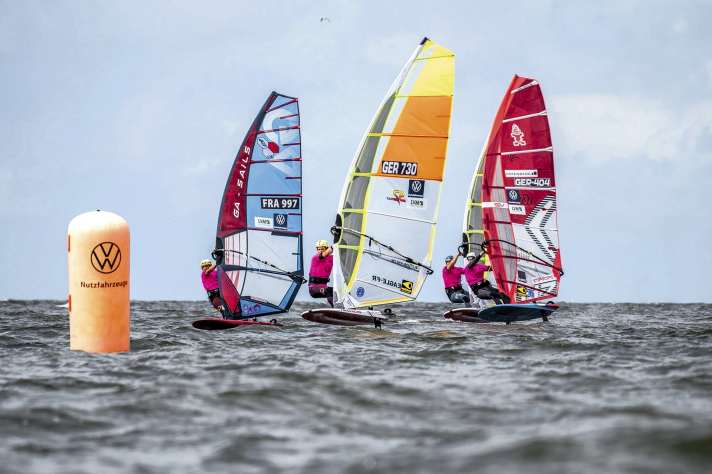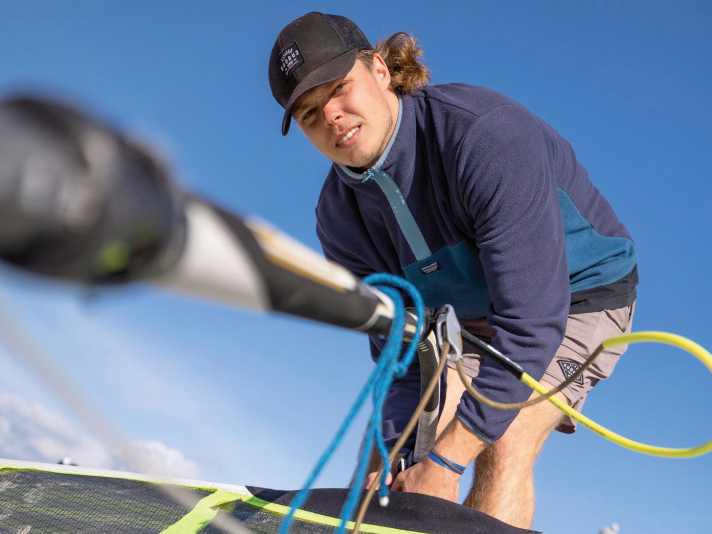





Lars Poggemann is one of the hot shots of the young German regatta scene and therefore not only a man for the podium in the German Windsurfing Cup in the coming years, but also has the potential to reach the very top. He also has ambitions to take part in World Cups in order to gain plenty of experience for the national races.
Lars, insiders already know your name from the results lists of the German Windsurfing Cup. But please introduce yourself briefly to those who are not so much into the regatta scene.
I'm 24 years old, have lived in Kiel for five years and originally come from Lake Chiemsee. My family windsurfs and so do my siblings, so I joined them quite automatically. And to be able to windsurf more intensively, I went to Kiel to study. Before I came to Kiel, I took a break for a year so that I could go windsurfing a lot. Here in Kiel, I'm often out in Grönwohld, Strande and - when there's too much seaweed in the Baltic Sea - on the Wittensee and Selenter See.
Ambitious windsurfers have been drawn to the windsurfing capital of Kiel for decades. What makes it special for you here?
I'll probably give the standard answer that many windsurfers have ready at this point: Kiel simply offers the perfect combination of studying and windsurfing. In Kiel, I get out on the water about three times a week during the summer months, and on top of that, it's my strong training partners that make training here so valuable. Fabi Wolf and Jonne Heimann are among the best German riders on the foil, and Michele Becker and Vincent Langer also come along from time to time. In the winter months, I try to go to Tenerife for several months for TWS slalom training. There I can train together with many professionals.
You just said it, "on the foil" - does riding on the fin still have a place for you at all?
Yes, occasionally. So the focus is clearly on foil. The season before last I was still doing fin, but last year I decided to only do foil slalom in order to achieve the best possible result. But for fun I like to go waving or slalom skiing.
What does it feel like for you to float on the foil?
It's a feeling of great freedom, you come up and suddenly everything goes quiet. And in the races, foiling is even more exciting because there are lots of battles!
And how does it feel to float or even race on a foil in Fuerteventura in 30 to 35 knots of strong wind? You took part in the Foil Slalom World Cup there for the first time in August 2024.
That's Next Level! You can also fall quickly. And it's extremely exhausting for your head!
How can you describe this "exhausting for the head"?
In principle, you have to remain fully focussed at all times. When foiling, it can quickly happen that the wings come out of the water and then you crash. That's why you have to be ready for the gusts at all times and actively pay attention to your surroundings.
And from your point of view, how does the comparison work out - from relaxed foiling in smooth water all to yourself to the 35 knots with rolling swells on Fuerteventura?
Sure, on the Wittensee at 15 to 20 knots it's relaxed sailing. On Fuerteventura, you're not just on your own, you also have to pay attention to the other participants and, of course, the tough conditions. You have to concentrate 100 per cent on that and simply have to be fit.

How do you equip yourself with boards and sails to be successful in the DWC?
At the DWC, we have the special rule that we only foil up to 20 knots, which is why the amount of material required there is not so high. Last season, I used two foil boards and three foil sails in the sizes 8.8, 7.8 and 6.8 square metres. With a foil you need two front wings, i.e. one large and one medium, and two back wings to be at the front. However, as I also take part in international regattas, I have foil sails in the sizes 5.0 and 6.0. There is also a 4.2 from S2 Maui, which I haven't bought yet, but probably will for the coming season.
Where do you think the greatest developments in materials are currently taking place?
New boards and sails come out every year, but foils are still the most advanced at the moment. If you really want to be at the front, it's important to have a fast foil. What's new now always varies from brand to brand. But as a rule, the new foil masts are thinner and stiffer, which gives you more speed and control. With wings, it always depends on the profile and the concept behind it. The sails and boards also improve from year to year, but the development of foils is much faster.
So you have absolutely competitive equipment. What are your goals in the Windsurfing Cup and perhaps also in the World Cup?
I definitely have competitive equipment. My goal in the Windsurf Cup is to always reach the podium and win a few tour stops over the next few years. In the World Cup, my personal goal is to finish in the top 20. But the racing there is completely different, which is why gaining experience is a goal first.
What does it take for you to win nationally?
Quite a lot, you have to sail faultlessly and your equipment has to be perfectly set up, as there is always a good field in the high-ranking regattas.
My goal in the Windsurf Cup is to always reach the podium and win tour stops in the coming years."
And what does it take on top to be able to ride at the very front at the international World Cups and World Championships?
You also need a lot of experience and everything has to be perfect, you have to test a lot and you need several masts for each sail size. The top riders spend a lot of time on the water to find the perfect setting for the material. The sail can behave completely differently with two different masts. There are also many different settings for foiling, i.e. how you set the backswing, how the mast is in the board and so on. All of this has to be tested before the competitions and the right set-up has to be found. In addition, the pros often have competition and training sails, as these also wear out.

Daniele Benedetti surprisingly won the Foil World Cup on Fuerteventura in 2024 for many outsiders and can almost be described as a newcomer to the World Cup. What do you think is the secret of his success?
He also invested a lot of time in training beforehand and then did his thing consistently at the World Cup. He always had good starts and made very few mistakes.
Let's stay with the stars of the scene. How did it feel for you to ride alongside the stars of the scene, such as Thomas Goyard and Pierre Mortefon, in the preliminary heats on Fuerteventura?
It was a good feeling because it was also a confirmation for me that I had already come quite far.
Then you race towards the first buoy, have Pierre Mortefon, the 2019 slalom world champion, next to you at the same height and it's a case of someone having to open the sail first. Is it still the case that you open up and back off?
Yes, unconsciously that's probably the case, because Fuerte was only my second World Cup and I'm more likely to open up at the neck buoy. When you have the top riders next to you, you have more respect for them than when I'm chasing Fabi Wolf and Jonne Heimann around the buoys on the Wittensee. So, yes, it's a mental story. But I think it will become more and more "normal" for me with more and more international races and that I will assert myself more and more in the future.
What experiences have you gained from your participation in the Foil Slalom World Cup on Fuerte?
First of all, I had some great experiences, but the bad races also put me in a bad mood more often. But I quickly got over it and thought about the next race. You learn from every race. You also have to attack a lot more and give your all on every lap. I was sometimes a bit shy at the starts because there are names next to you that you have respect for. But that got better and better as the races went on.
But you practise the starts over and over again in the run-up to the season at the TWS training in Tenerife.
Yes, it looks so simple at first!
So on Fuerte, the starts of most of the pros looked breathtakingly good as they surfed across the line with perfect timing! An amateur racer can probably hardly imagine how you can be exactly at zero on the start line at over 60 km/h.
For example, the wave conditions on Fuerteventura are different to those on Tenerife, where we train the TWS slalom programme in winter with many, many starts and with some top riders from the World Cup. The waves are different on Tenerife than on Fuerteventura. On a day with incoming swell on Fuerteventura, I almost parked up, and there are a few details that vary from spot to spot. Every start is different, so more experienced riders have more experience and can deal with more situations.
What difference does it make to take part in races in the National Cup compared to those in the World Cup?
A big difference are the no-rules (No classic right of way rules apply, editor's note, more here) in the World Cups. Furthermore, you can't afford to make any mistakes in the World Cup because there are more at the same level. And at national level, you can make a mistake and still make it through to the next round in the slalom heats.
And what does your joint training look like at national level, for example on Lake Wittensee?
We do various training sessions. If I want to test material, I only need one sparring partner. We ride side by side and then I make some changes to my set-up on the beach. Then we go out on the water again, side by side, and it's important that my training partner doesn't change his equipment. Or we look for a buoy on the water and simulate jibe situations.
How do you actually train the starts?
We need a buoy and someone on a boat to film and whistle the starts. There is also a fun regatta such as the Racer of the Sea, which gives us ideal practice conditions.
What is the easiest way to enter the regatta?
If you live in the north, then it's easy to get started with the Racer of the Sea regattas or directly in the DWC, where you can get by with very little equipment. If you live in the south, then there is the Swiss Slalom Tour, and the Austrians also do something. In addition, there are often regattas on Lake Garda, which is closer to most southern Germans than the North and Baltic Seas.
If you could, what three things or skills would you like to steal from other regatta professionals?
Hmm (smiles, thinks about it), Daniele Benedetti's starts! At zero with full speed! Usually in the centre of the start line. He had the best starts on Fuerte.
Okay, what else? Maybe Pierre Mortefon's jibes? Those were announcements!
I'm in, the jibes from Mortefon, yes!
And the third?
A difficult question. I'm tall and have a good body weight. But yes, then the speed!
From whom?
He didn't overdo it in the competition, but Thomas Goyard was already really fast in training before the World Cup on Fuerteventura, and I thought he would at least finish the World Cup on the podium.
More windsurfing pros and their "steal lists":
Facts Lars Poggemann
- Age: 24years
- Place of residence: Keel
- Profession: Student
- Size/weight: 191 cm/ 98 kilos
- Surfing since: the age of 10
- Regatta debut: Chiemsee Cup
- Discipline: Foil Slalom
- Successes: 3rd place annual ranking DWC 2023, 1st place DWC St Peter Ording 2023, 3rd place DWC Heiligenhafen 2024, 5th place European Pro Windsurfing Tour
- Hobbies: Skiing, fitness
- Favourite spots: Kiel-Schilksee, Grönwohld, El Médano
- Sponsors: S2 Maui, FMX Racing, F4 Foils, Surfline Kiel, Söoruz
- Instagram lars_poggemann

